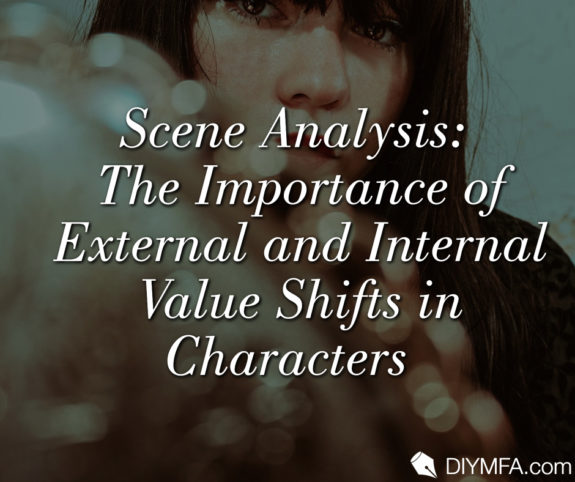Have you ever read a scene and felt like it didn’t go anywhere, or didn’t have a purpose? Do you struggle to write scenes that develop characters? On a scene-by-scene basis, do your characters experience external and internal changes? Do you do in depth scene analysis?
Whether or not published in a book or jotted down in a first draft, scenes that feel flat often lack a source of plot advancement or character development. Often the reason for this is because they lack one or more of the five commandments–important beats driving a scene, which I review in depth in my Story Grid Scene Analysis article here.
As a writer hoping to learn how to read with a purpose, mastering the five commandments when doing scene analysis is a great start. The reason for this is because when the five commandments are applied, the scene contains a moment that forces a protagonist or leading character into a Crisis Decision, and this decision is made in response to the obstacle (that is an Action or Revelation) preventing them from achieving their present goal.
And when this decision is made, the characters (and the forward moving plot) are changed on an internal and external scale.
For example, in Disney’s Beauty and the Beast’s famous Climax (when Beast is finally transformed back into the body of a human), multiple characters are changed on an external and internal spectrum. It’s important that both are achieved, and the concentration on both is what makes the scene extra memorable.
Ultimately, a scene will likely direct a stronger focus on a character’s internal or external shift. When doing a scene analysis, the two types of change should be viewed in how they support one another instead of as two separate details.
Why Scenes Need an External and Internal Change
There are two types of change in a character from the beginning of the scene to the end: an external change and an internal change.
An external change is a change in a character’s physical state of being. This focuses on the character’s position tied to their mortality and position–something that, looking at this with its most extreme perspective, determines a character’s relation to life and death.
An internal change relates to a character’s internal thoughts according to their external surroundings. From this angle, we’re looking at how a character is mentally/psychologically doing. How are they feeling, and how is that feeling altered from the beginning of the scene to the end?
When doing scene analysis, writers and readers should keep in mind how important it is that a character or characters undergo both an internal and external shift in each scene (even if the external shift or internal shift takes precedence depending on the surrounding factors supporting the scene). When both an internal and external change is experienced, we see the plot move forward (externally) and the character(s) developed (internally).
And in some cases, the external shift and the internal shift might belong to different characters in the same scene. Super cool!
Let’s turn back to Beauty and the Beast to see this as an example.
The Five Commandments in The Transformation Scene
Before looking at how Belle and Beast, the protagonists, internally and externally change in the Climax of Beauty and the Beast, consider how the five commandments work in this scene:
Inciting Incident: Causal. (In Medias Res) In the scene before this one, Gaston stabbed Beast. Although Gaston is dead by the beginning of the transformation scene, the knife stabbed in Beast’s back acts as a causal disturbance to Beast’s physical state and Belle’s internal one. Belle finds Beast dying on the balcony.
Turning Point: Action. Beasts dies (this throws Belle into a Crisis Decision). (You could also argue this is when Beast transforms into a man.)
Crisis: Best Bad Choice. Belle can leave Beast’s body behind or declare her love for him as she mourns. (You could also argue that her Crisis is after Beast transforms, and she debates whether or not to believe Beast is who he says he is.)
Climax: Belle declares her love for Beast (this shows her acting on her Crisis Decision) before the last rose petal falls. Beast is transformed back into a man and Belle recognizes him for him. They kiss and the enchantment falls away from the castle and servants. Beast and Belle celebrate with everyone.
Resolution: Belle and Beast (and the castle servants) are united as humans. They live happily ever after.
Notice how there are a couple of ways that you can do scene analysis, based on how some different options determine the Turning Point and Crisis Decision in this scene. Regardless of what option you prefer, each supports an internal/external shift in Belle and an external/internal shift in Beast; thus, there’s a victory for love, life, and a worldview change in the scene and for the characters as a whole.
To understand this a bit more, read on to see how the internal shift in Belle unfolds because of her Turning Point and Crisis Decision, and how Belle’s decision also creates an external shift in her state of being–and Beast.
The Internal Change in Belle
At the beginning of this scene, Belle is devastated. She feels responsible for the raid on the castle (she was the one who showed the townspeople there was a beast), and Beast is dying because of Gaston. She holds Beast in her arms, and he smiles at her. He’s surprised and pleased that she has returned to him, even if he is only getting to see her one last time. Belle holds out, hoping that Beast will survive until he dies.
Looking back at the five commandments, this is when an Action (Beast’s death) throws Belle into a Crisis Decision–she can leave or stay with him. Belle stays and whispers that she loves Beast, despite knowing that her words fall short because he’s not alive to hear them.
But there’s hope! Since Belle pronounces her love for Beast before the last rose petal falls, the enchantment is lifted. Beast not only comes back to life but is turned back into a man. What a Climax!
This is when Belle looks at Beast and determines that he is the man she loves. They kiss, which further lifts the curse that traps the castle and the servants.
Finally, Belle and Beast–deeply in love–find their happily ever after. Belle shifts from an internal state of devastation to joy and euphoria and on an external scale of alone to united with the man she loves, although I think Belle’s internal shift is the louder change in this scene, compared to Beast, whose external shift is greater.
The External Change in Beast
Following the same commandments, Beast moves on the external scale from severely injured/death to life. He also experiences an internal shift from hopeless to victorious since Belle’s love for him restores his external state of being as 1) the physical form of a cursed beast, and 2) dead.
While both Belle and Beast experience internal and external shifts, I’d credit the focus of this scene on Belle’s internal shift because Beast’s changes are a direct result of her decision and actions, instead of the other way around. Together, you could also argue that the greatest change in this scene is based on how Belle and Beast move from love to intimacy–they’ve gained the highest level of romance because of the sacrifices they’ve made for one another, and their worldview shifts.
The Big Takeaway
While you can debate whether or not the internal shift in a character or external shift in a character’s state of being is more important in a scene, that same character must be forced into a Crisis Decision by an obstacle in order to experience either. Also, whether or not you think the internal or external shift is more important is secondary to the importance of how both exist because of the other.
Think of internal and external changes in a character more as a cause-and-effect rather than two separate entities existing in the same moment. They work together to illustrate an advancement in plot and development of character, and because they do, the scene gains great meaning.
Now It’s Your Turn
Now that we’ve looked at how internal and external shifts work for multiple characters in the Climax of Beauty and the Beast, see if you can identify an internal and external shift in one or more characters for another scene in the movie. Pull out the five commandments in your scene choice and identify how the Turning Point and Crisis Decision determine the internal and external changes in a character. Once you’re done, share your analysis in the comments section so we can all practice how to read with a purpose!
P.S. I’d love to hear more about your scene analysis from another Disney classic (or book favorite). Visit my website at www.abigailkperry.com to connect with me and share your thoughts. I can’t wait to hear from you! ]

Abigail K. Perry is a Certified Story Grid Editor with professional teaching, literary agency, and film production experience. In addition to writing masterwork guides that help people learn how to write, read, and edit like a writer, she works as a freelance developmental editor/book coach and diagnostic editor, and is a monthly columnist for DIY MFA. Abigail also teaches Genre-Focused writing workshops for the genres she specializes in, which include Women’s Fiction, YA Fantasy, Upmarket Fiction, Historical Fiction, and Scripts. As a podcaster, she’s a passionate advocate for the butterfly effect stories have on the individual and world, which she shares with listeners on her podcast, STORY EFFECT. Visit Abigail’s website if you’re a writer looking for an editor who will help you grow as storyteller, and who has experience in differentiated instruction, traditional publishing, and film.







